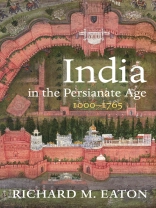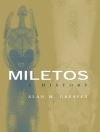Protected by vast mountains and seas, the Indian subcontinent might seem a nearly complete and self-contained world with its own religions, philosophies, and social systems. And yet this ancient land and its varied societies experienced prolonged and intense interaction with the peoples and cultures of East and Southeast Asia, Europe, Africa, and especially Central Asia and the Iranian plateau.
Richard M. Eaton tells this extraordinary story with relish and originality, as he traces the rise of Persianate culture, a many-faceted transregional world connected by ever-widening networks across much of Asia. Introduced to India in the eleventh century by dynasties based in eastern Afghanistan, this culture would become progressively indigenized in the time of the great Mughals (sixteenth, seventeenth, and eighteenth centuries). Eaton brilliantly elaborates the complex encounter between India’s Sanskrit culture—an equally rich and transregional complex that continued to flourish and grow throughout this period—and Persian culture, which helped shape the Delhi Sultanate, the Mughal Empire, and a host of regional states. This long-term process of cultural interaction is profoundly reflected in the languages, literatures, cuisines, attires, religions, styles of rulership and warfare, science, art, music, and architecture—and more—of South Asia.
قائمة المحتويات
List of Illustrations
List of Maps
Acknowledgements
Introduction Stereotypes and Challenge
Two Transregional Worlds: Sanskrit and Persianate
1 The Growth of Turkic Power, 1000–1300 A Tale of Two Raids: 1022, 1025
Political Culture in the Sanskrit World
Political Culture in the Persianate World
The Ghurid Conquest of North India, 1192– 1206
The Delhi Sultanate under the Mamluks, or Slave Kings
Conclusion
2 The Diffusion of Sultanate Systems, 1200–1400 Imperial Expansion Across the Vindhyas
Settlers, Shaikhs and the Diffusion of Sultanate Institutions
The Early Bengal Sultanate
Sultanates of the Deccan: the Bahmanis and Vijayanagara
The Early Kashmir Sultanate
The Decline of the Tughluq Empire
Conclusion
3 Timur’s Invasion and Legacy, 1400–1550
Overview
Upper India
Bengal
Kashmir
Gujarat
Malwa
Emerging Identities: the Idea of ‘Rajput’
Writing in Vernacular Languages
Conclusion
4 The Deccan and the South, 1400–1650
Links to the Persianate World
Successors to the Bahmani State
Political and Cultural Evolution at Vijayanagara
Gunpowder Technology in the Deccan
Cultural Production in the Gunpowder Age
Vijayanagara’s Successors and South India
Conclusion
5 The Consolidation of Mughal Rule, 1526–1605
Overview
Babur
Humayun
Akbar’s Early Years
Emerging Identities: Rajputs
Mughal Expansion Under Akbar
Akbar’s Religious Ideas
Conclusion
6 India under Jahangir and Shah Jahan, 1605–1658
Jahangir
The View from the Frontier
The Deccan: Africans and Marathas
Emerging Identities: the Idea of ‘Sikh’
Assessing Jahangir
Shah Jahan
Conclusion
7 Aurangzeb – from Prince to Emperor ‘Alamgir, 1618–1707
Prince Aurangzeb – Four Vignettes
War of Succession, 1657–9
‘Alamgir’s Early Reign
Emerging Identities: the Marathas from Shahji to Tarabai
‘One Pomegranate to Serve a Hundred Sick Men’
Religion and Sovereignty Under ‘Alamgir
Conclusion
8 Eighteenth century Transitions
Political Changes, 1707–48
Maratha Uprisings
Sikh Uprisings
Emerging Identities: Muslims in Bengal and Punjab
Early Modern Globalization
Conclusion
Conclusion and Epilogue
India in the Persianate World
The Mughals in the Sanskrit World
The Lotus and the Lion
Towards Modernity
Notes
Index
عن المؤلف
Richard M. Eaton is Professor of History at the University of Arizona and the author of several groundbreaking books on India before 1800, including the classic The Rise of Islam and the Bengal Frontier.












